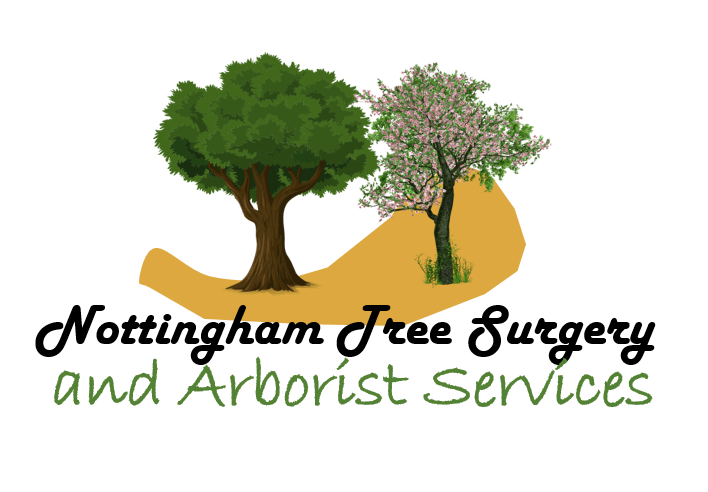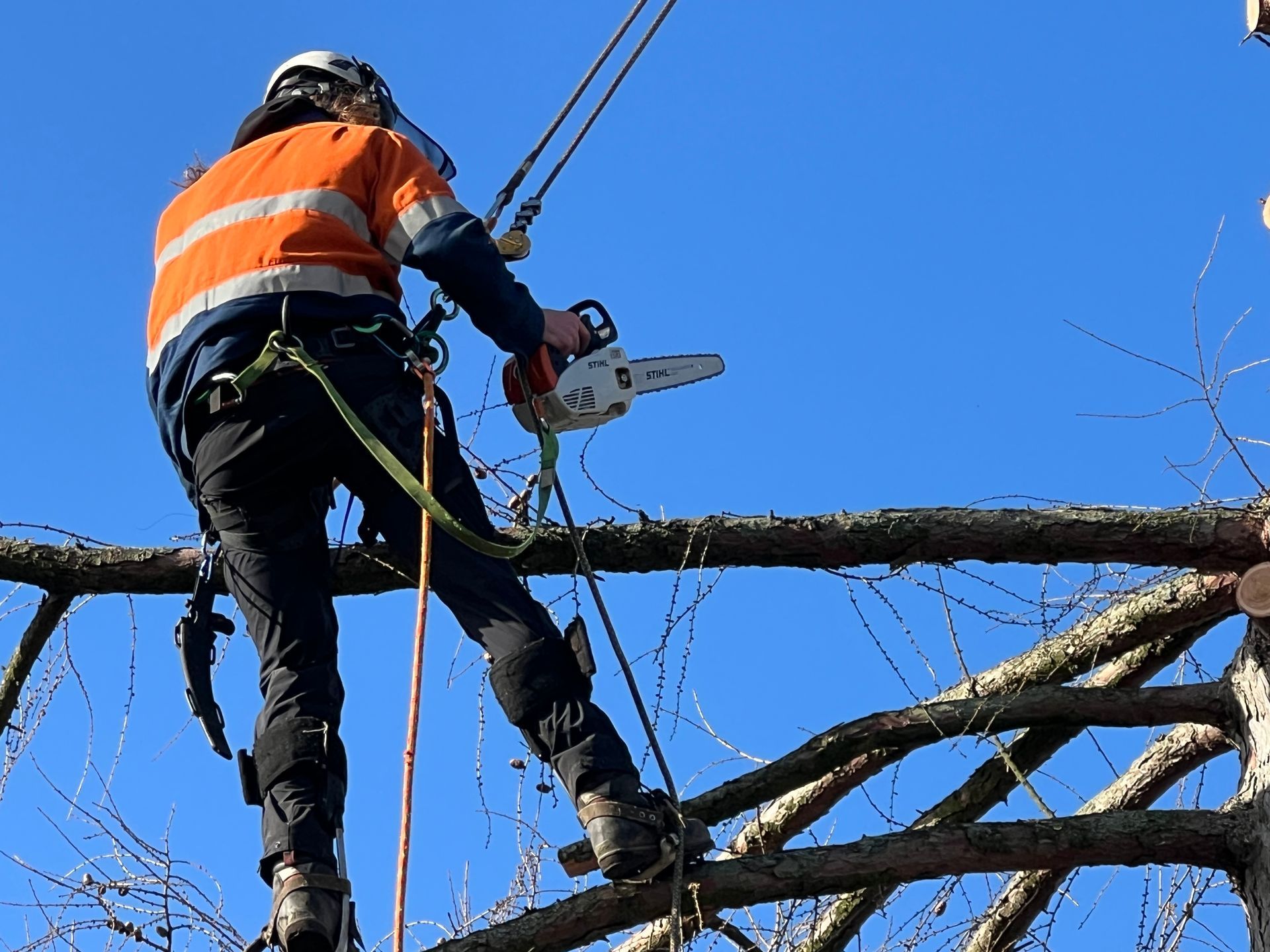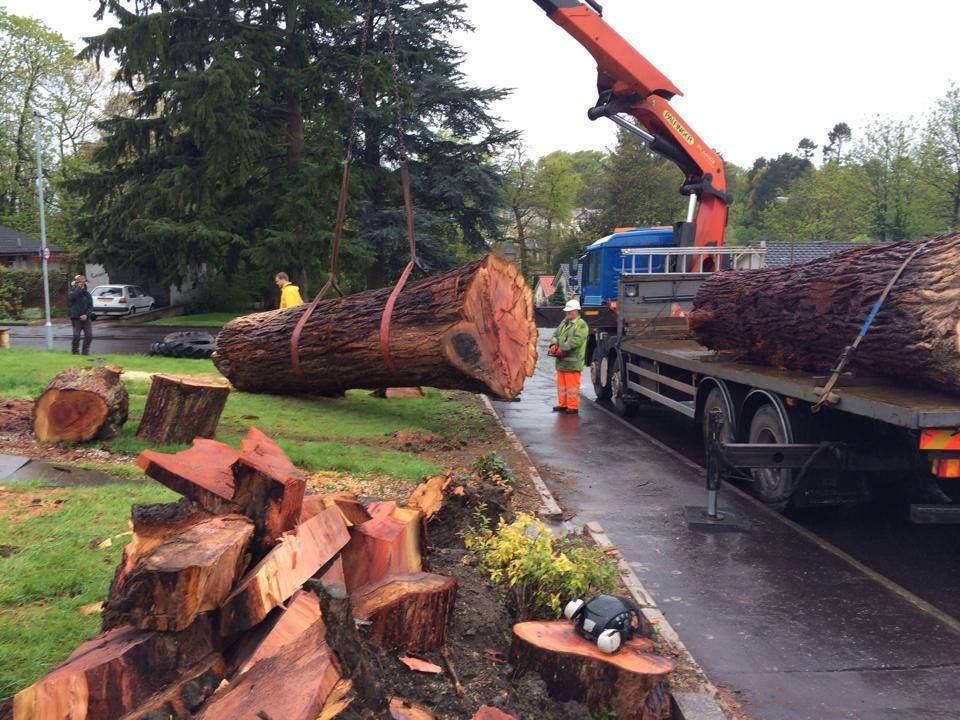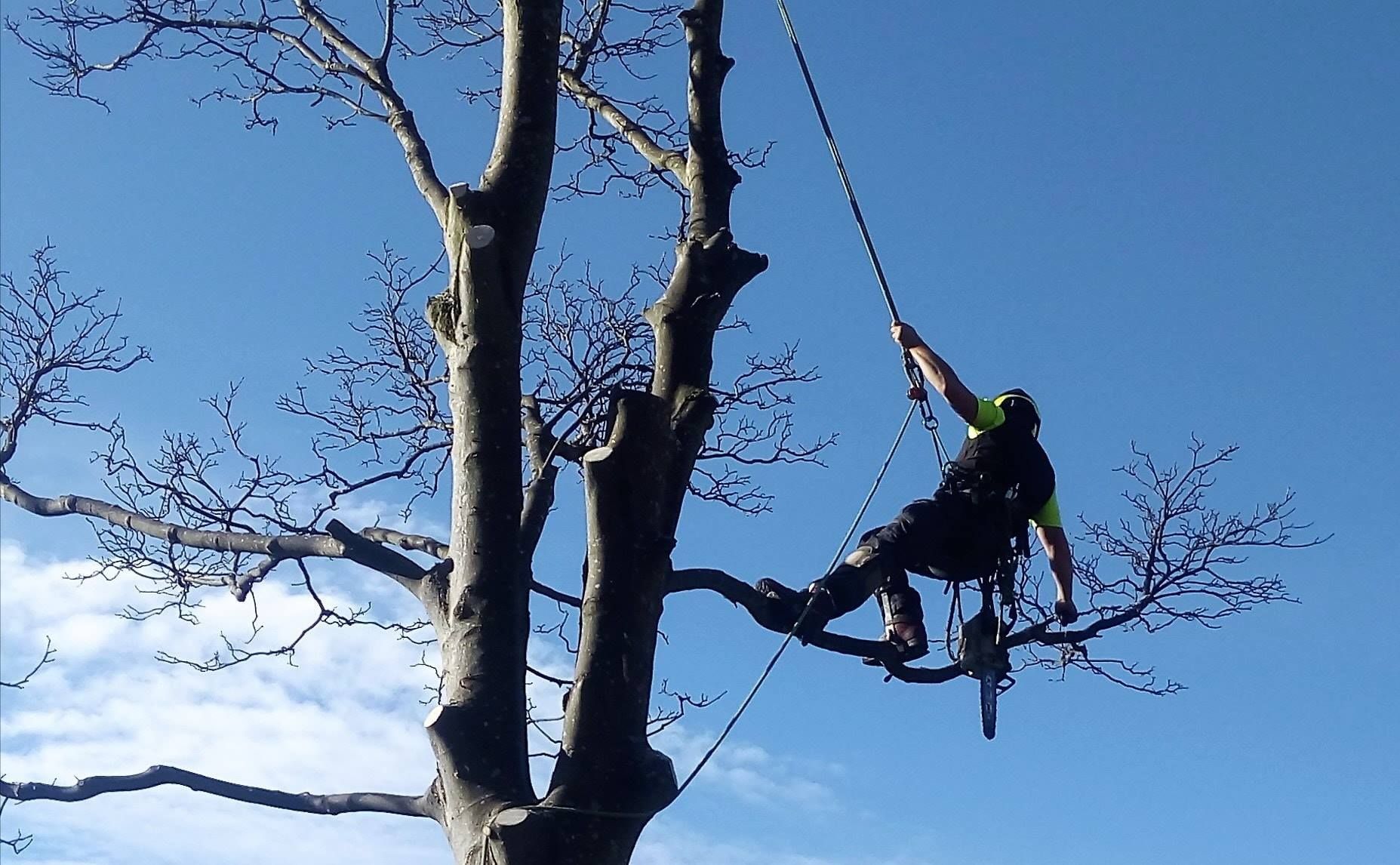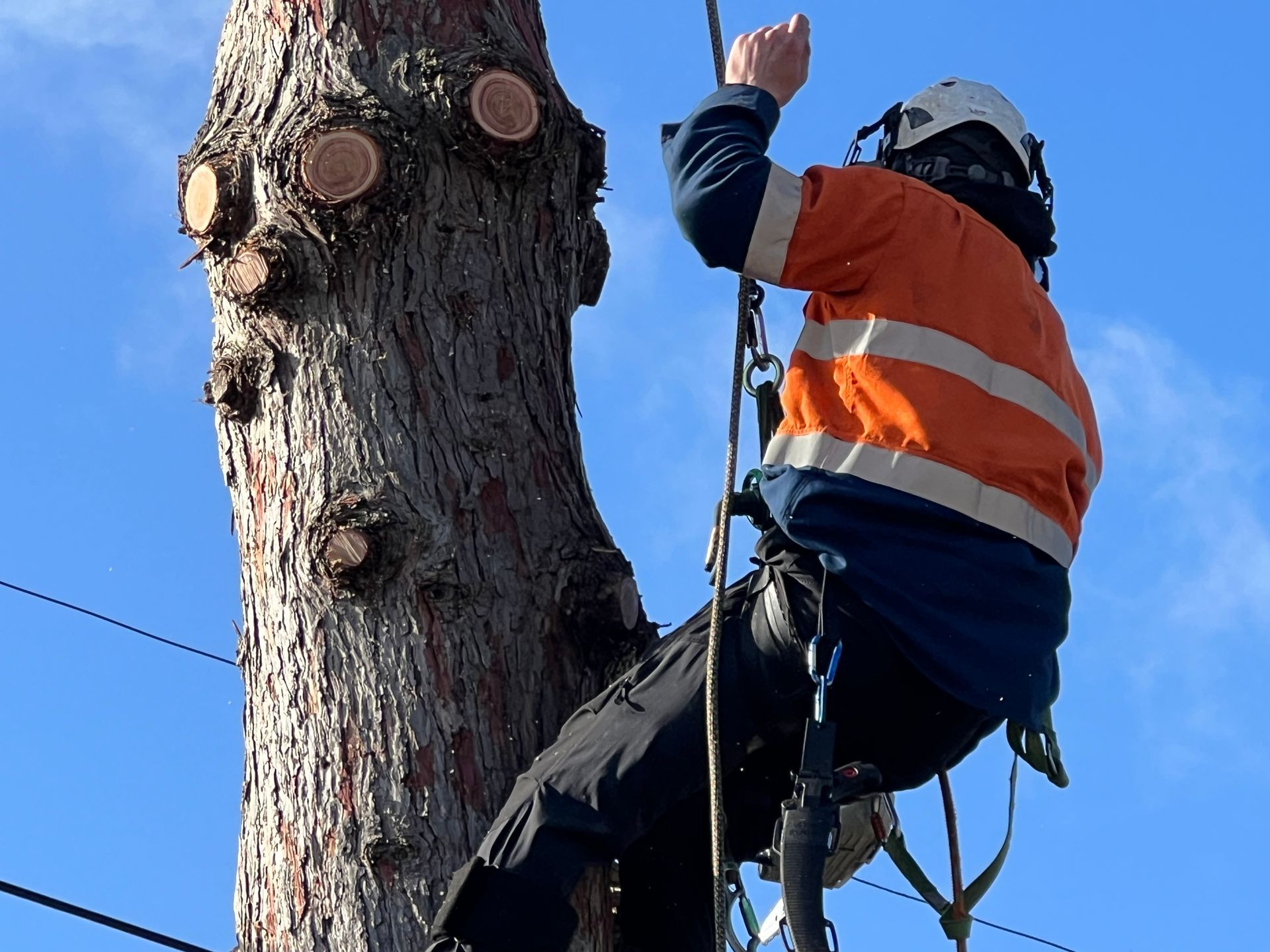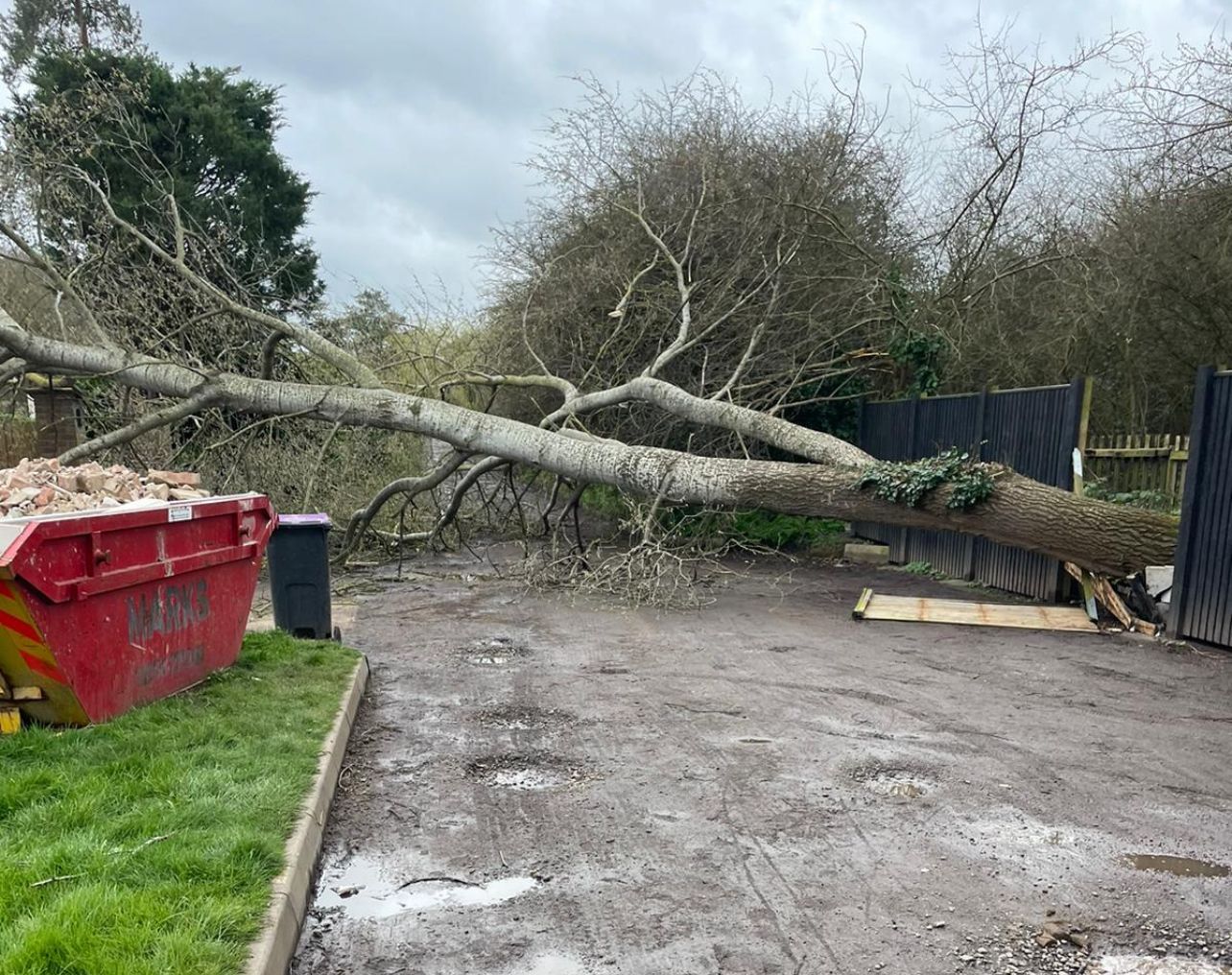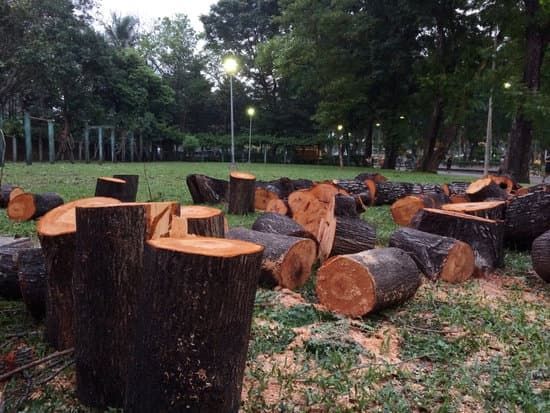Expert Tree Removal in Nottingham & Surrounding Areas
Are you facing problems with a hazardous or unwanted tree on your Nottingham property? Our professional tree removal service provides safe, efficient solutions when you need them most. Whether your tree is diseased, damaged by storms, or simply in the wrong location, our certified arborists and tree surgeons can help.
Why Nottingham homeowners and businesses choose us:
- ✓ Fully certified and insured tree surgeons
- ✓ Free, no-obligation assessments
- ✓ 24/7 emergency tree removal service
- ✓ Complete cleanup included with every job
- ✓ Serving Nottingham, Derby, West Bridgford and all surrounding areas
- ✓ Extensive knowledge of Nottingham's diverse tree species and ecosystems
- ✓ Familiar with all local Tree Preservation Order (TPO) regulations
Call us today on
0115-647-0351 for your free assessment or fill out our quick enquiry contact form above
Professional Tree Removal Services in Nottingham
When a tree becomes hazardous or unwanted, our team of certified arborists provides safe, efficient removal solutions. With over 15 years of experience serving Nottingham and surrounding areas, we handle everything from initial assessment to complete cleanup, ensuring your property remains safe and beautiful.
Our Tree Removal Process
- Initial Assessment - We carefully evaluate the tree's condition, location, and surrounding environment
- Custom Removal Plan - We develop a strategic approach specific to your tree and property
- Safe Execution - Using specialised equipment and proven techniques, we safely remove the tree
- Complete Cleanup - We leave your property spotless, with all debris properly disposed of.
Types of Tree Removal Services in Nottingham
Complete Tree Removal
Our comprehensive tree removal service handles trees of any size, from small ornamentals to towering mature specimens. Using our hi-tech specialised arborist equipment and advanced rigging techniques, we safely dismantle and remove the entire tree, including branches, trunk, and surface roots, leaving your property clean and ready for new landscaping.
We understand the importance of maintaining tree diversity in Nottingham, and work according to the urban forestry "10-20-30 rule" - recommending that urban tree populations include no more than 10% of any single species, 20% of any genus, or 30% of any family. This diversity helps protect against devastating diseases and pests that could otherwise decimate Nottingham's tree population.
Sectional Dismantling
Perfect for trees in confined spaces or near structures, our tree felling and sectional dismantling method removes trees piece by piece with precision control. Our skilled climbers carefully lower each section using specialised rigging equipment, ensuring zero damage to surrounding property, gardens, or structures. This technique is ideal for Nottingham's urban properties where space is limited.
Emergency Tree Removal Service
When storms strike Nottingham and surrounding areas, damaged or fallen trees require immediate attention. Our 24/7 emergency tree removal team responds quickly to:
- Fallen trees blocking access
- Storm-damaged trees threatening property
- Trees leaning dangerously after high winds
- Branches hanging precariously over structures
Nottingham experiences approximately 1,390 hours of sunshine annually and around 709 mm of rainfall per year, creating conditions that support vigorous tree growth but can also contribute to storm-related emergencies during extreme weather events.
Call our emergency line at 0115-647-0351 for immediate response.
Crane-Assisted Removal
For extremely large trees or those in hazardous positions, we offer crane-assisted removal. This specialised service allows us to safely lift entire sections of trees over buildings, power lines, or other obstacles, minimising risk while maximising efficiency.
The historic architecture of Nottingham, including over 800 listed buildings, requires special consideration during crane operations. Our team is experienced in working near heritage properties, from the medieval buildings in the Lace Market to Victorian villas in The Park estate.
Conservation Area and TPO Tree Removal
Trees in Nottingham's conservation areas or those protected by Tree Preservation Orders (TPOs) require special permissions before removal. Our team handles all necessary applications and documentation, ensuring your tree removal complies with local regulations while reducing delays.
Nottingham currently has over 5,000 individual trees under Tree Preservation Orders across the city, with some TPOs dating back to the 1950s. Our team maintains a comprehensive database of protected trees and can quickly determine if your tree requires special permissions.
Hazardous Tree Removal
Trees that pose imminent risks due to disease, structural weakness, or storm damage require professional assessment and removal. Our certified arborists identify hazardous conditions and implement appropriate removal strategies to eliminate dangers before they cause property damage or personal injury.
Nottingham's changing climate has increased the prevalence of tree diseases like Ash Dieback and Oak Processionary Moth, affecting approximately 15% of the city's tree stock. Our arborists are trained to identify these specific pathogens that may compromise tree safety.
Stump Removal and Grinding
Complete your tree removal project with our comprehensive stump removal services. Using specialised grinding equipment, we remove unsightly stumps below ground level, eliminating tripping hazards and allowing for new landscaping or construction. Our powerful grinders make quick work of tree stumps and surface roots of any size.
Nottingham's soil, which varies from the clay-heavy areas in the south to sandier compositions in the north, affects both stump decay rates and grinding difficulty. Our equipment is specifically selected to handle these variable soil conditions effectively.
All our tree removal services include thorough cleanup and debris removal, leaving your property neat and tidy. Contact us today for a free, no-obligation assessment of your tree removal needs
When Is Tree Removal Necessary?
Signs Your Tree May Need Removal
- Dead or Dying Tree - More than 50% of the tree has dead branches or shows minimal leaf growth
- Structural Problems - Leaning trunk, V-shaped or multiple trunks with visible cracks
- Disease or Pest Infestation - Signs include discolored leaves, fungi at the base, or emergence holes
- Root Problems - Heaving earth, fungi growing near the base, or visible root damage
- Safety Concerns - Tree is growing under power lines or too close to structures
- Storm Damage - Severe structural compromise after weather events
Invasive Species Issues - Some non-native species like Norway Maple can become invasive in Nottingham's ecosystem, affecting biodiversity and potentially requiring removal to protect native species
Poor Species Selection - Trees planted in unsuitable locations for their growth habits, particularly relevant in Nottingham's varied urban environment
Our Nottingham tree surgeons can assess your tree and provide professional advice on whether removal is necessary or if alternative solutions might be possible.
Tree Removal Costs in Nottingham
Are you wondering how much it costs to remove a tree from your Nottingham property? Tree removal costs vary based on several key factors, and understanding these will help you budget appropriately for your project.
In Nottingham, tree removal costs are typically 10-15% higher than the national average due to the city's high concentration of protected trees, conservation areas, and the specialised equipment often required to work in densely populated urban neighbourhoods.
The cost of tree removal in Nottingham depends on several factors:
- Size and height of the tree
- Location and accessibility
- Tree species and condition
- Additional services required (stump removal, debris clearing)
- Any permissions needed for protected trees
Proximity to historical structures or underground utilities, which are particularly prevalent in Nottingham's older neighbourhoods Seasonal factors - winter removals are often 5-10% less expensive than peak summer services
We provide transparent, detailed quotes with no hidden fees.
Please Note: All tree removals are subject to survey
Contact us today for a free, no-obligation assessment and quotation for your tree removal needs.
Why Choose Our Nottingham Tree Removal Service?
Expert Tree Surgeons
Our team consists of certified arborists and tree surgeons with specialized training in safe tree removal techniques. We continuously update our skills to provide the most efficient and safest tree removal services in Nottingham.
Every member of our team is trained in Nottingham's specific urban forest management practices, with particular expertise in working with the city's most common species - including English Oak, Sycamore, Ash, and Silver Birch, which together make up over 60% of Nottingham's tree population.
State-of-the-Art Equipment
We've invested in the latest tree removal technology and equipment, allowing us to safely remove trees of any size without damaging surrounding property. Our hi-tech tools ensure efficient, precise tree removal every time.
Our equipment includes special low-impact machinery designed for Nottingham's numerous conservation areas, including The Park, Lace Market, and the Arboretum district, where minimal ground disturbance is essential.
Commitment to Safety
Safety is our top priority. We follow strict safety protocols, use proper protective equipment, and plan each removal meticulously to lower the risks to your property and our team.
Our team has an exemplary safety record with zero major incidents over 15 years, even while working in some of Nottingham's most challenging urban environments, including the steep slopes of The Park estate and the narrow streets of Sneinton.
Environmental Responsibility
We're committed to environmentally responsible practices. When possible, we recycle removed trees into mulch or firewood, reducing waste and giving your tree a second life.
We partner with local Nottingham wood artisans and furniture makers to repurpose quality timber from removed trees, and have contributed to several community projects including benches for Nottingham's Green Flag award-winning parks and gardens.
Comprehensive Insurance
Our tree removal service is fully insured, giving you peace of mind that your property is protected throughout the removal process.
Our coverage exceeds Nottingham City Council's requirements for contractors working near heritage properties and protected structures, with specific provisions for the unique risks associated with Nottingham's historic buildings.
Local Customer Reviews For Our Tree Removal Service in Nottingham
Here are some customer reviews from our fantastic Nottingham customers. We thank them and hope to serve them again in the near future.
Review from
Mr T. Johnson, NG1 "I had a massive oak tree that was dangerously close to our house, and I was really worried about it coming down in a storm. George and the team from Nottingham Tree Surgery and Arborist Services was amazing! They carefully removed the tree with no damage to our property and even cleared up every last branch. The service was prompt, professional, and very reasonably priced. Highly recommend them!"
Review from
Mr & Mrs Cottis, NG7 "I contacted Nottingham Tree Surgery and Arborist Services to remove a dead tree from our back garden. They arrived on time, were very polite, and did an excellent job. What impressed me most was how clean they left the site afterward. You wouldn't even know a tree had been there! Great service, and I’ll definitely use them again."
Review from
Mrs B. Parfitt, NG9 "We had a large tree that needed removal due to root damage to our driveway. The crew from Nottingham Tree Surgery and Arborist Services handled the job expertly. They worked efficiently and safely, and the whole process was hassle-free. Plus, their pricing was very competitive. We’re in NG9, and it's great to have such a reliable service in our area."
Review from
M. Patel, NG5 "George and his lads at Nottingham Tree Surgery and Arborist Services did a fantastic job removing a dying tree that was leaning dangerously close to our home. They were professional, knowledgeable, and made sure the job was done safely. I was also impressed by how tidy they left our garden. Top-notch service that I would highly recommend to anyone in Nottingham."
Review from
L. Flindall, NG3 "Nottingham Tree Surgery and Arborist Services was recommended to us by a neighbour, and they didn’t disappoint. We had a large, old tree that needed to be taken down, and the team handled it with absolute precision. They were quick, careful, and cleaned up perfectly afterward. We’re really pleased with the outcome and the fair pricing. Would definitely use them again!"
Review from
C. Gleddis, NG2 "I had an urgent need to remove a large tree that had started leaning after a recent storm. The team from Nottingham Tree Surgery and Arborist Services responded quickly and had the tree down safely in no time. Their expertise and professionalism were evident throughout, and the clean-up was impeccable. Highly recommend them for any tree removal jobs in Nottingham!"
Review from
Dr. J. Wentworth, NG6 "As a local ecologist, I was concerned about the removal of a mature tree on my property. The team took time to discuss environmentally sensitive options and even suggested planting two native replacements. Their knowledge of Nottingham's biodiversity initiatives and careful work around existing wildlife habitats was impressive. A truly responsible service." and nice guys too!
Now you know who to call, for all your tree removal needs in Nottingham!
Contact Us for Tree Removal in Nottingham
Ready to safely remove that problem tree?
Contact our Nottingham tree removal experts today for a free, no-obligation assessment.
Phone:
0115-647-0351
Email: treesurgerynottingham@gmail.com
Contact Form:
Fill out a few details and we will contact you within 24/hours
Address: 20 Prince Street, Long Eaton, Nottingham, NG10 4LH
Get Your Free Tree Removal Quote Today!
Serving all Nottingham postcodes including NG1, NG2, NG3, NG4 NG5, NG6 NG7, NG8 NG9, NG10 and surrounding Nottinghamshire areas.
More Important Information About Tree Removal
Falling Tree Risk Factors
Trees are beautiful, Nothing is more peaceful than the serenity of sitting under the shade of a tree on a summer afternoon. Therefore, removing trees is not something we love doing. Nonetheless, when a tree becomes too big, it presents an opportunity to cause harm to you, your family, and your lovely home.
While a tree can be maintained to keep it healthy and beautiful, some situations call for complete tree removal. A big tree that has large branches can easily break and fall on a vehicle or your house during a storm or intense snow. Besides, if your tree is growing near a power line, you do not want to be the reason why your entire neighbourhood has no electricity.
A damaged or a dead tree might also need removal. However, removing a tree is very dangerous and wrought with difficulties to an amateur. An inexperienced person can land themselves many severe injuries if they try to eliminate a tree from their compound. That is why you need our tree removal professional services.
Hi-Tech Tree Removal Equipment And Machinery
Nottingham Tree Surgery and Arborist services have invested significantly in the latest hi-tech tree removal equipment. Our equipment is intelligent as well as high-powered. Hence, we can successfully remove any tree from the soil without damaging the roots. Also, the equipment makes the entire process easy and fast.
Therefore, with us, you can be sure that no harm or damage to your property or surroundings will occur during the tree removal process. Moreover, since our removal procedure does no damage to the tree, we can relocate it from one location to another without compromise if this is your wish.
Our tree removal services are also safe enough to ensure that any trees near power lines or telecom systems are eliminated without any incident. We have specialised equipment for such occasions. If deemed fit, we can also remove the tree manually to prevent any damage to your property.
Part of our removal services is to process the tree into mulch if this is your preference. Therefore, you can trust our versatility to cater to any of your needs. Our Tree Surgeons and Arborists are also experts in determining whether a tree is damaged or dead.
We have many tree removal methods at our disposal including tree felling and sectional dismantling and some times we have to utilise heavy duty cranes if the need arises.
Hence, if unsure, you can call us for a consultation, and our Arborist will conduct an analysis on the premises. If the tree can be saved, we will work with you to aid in its recovery. Otherwise, we will ensure the entire tree has been removed. No roots or stumps will be left to cause harm to you or your soil.
In case you decide to remove the tree yourself, we recommend that you get advice from our professionals. Some rules should be followed during a tree removal exercise. For instance, never climb on a ladder with a chain saw. Also, never try to remove a tree that has a diameter of ten inches or above on your own.
Instead, contact our specialist tree removal services and avoid unnecessary costs on tools or severe injuries. We are already armed with all the knowledge, resources, and materials that you will need to get your tree removed. Take advantage of us by contacting us and saving yourself a trip to the hospital.
Why Remove A Tree in The First Place?
Tree infections are common and can be caused by a variety of factors. Signs that your tree may be infected include crown dieback, cracks in the bark (deep splits), misshapen or discoloured leaves, soft crumbly wood or fungi on the growing area. If you notice emergence holes with feeding galleries around them, this could also indicate an infection from pests like borers.
By removing infected trees, you can help to prevent the spread of disease and ensure the health of your garden for years to come. Removing an infected tree is not only important for protecting other plants, but it could also save you from more expensive treatments or even property damage down the line should the infection worsen significantly.
If you're dealing with a serious tree infection, it's best to consult with our professional arborist and tree removal specialists to determine the best course of action. They will be able to inspect your tree and offer advice on how to treat the pest or fungus in question. Depending on the severity of the infection, they may even recommend that you remove the tree entirely if other methods are not successful.
Our arborists will also provide you with advice on how to prevent further infection or disease in the future. This could include tips about proper pruning and handling of plants, soil conditioning techniques, and appropriate watering practices. We can also provide recommendations on suitable replacements for any trees that must be removed due to infection. This may help you maintain a balanced and healthy landscape while ensuring that the trees on your property are safe and healthy.
We look forward to helping you address your pest or disease issue in an environmentally conscious way.
If you require any other type of tree related service then click here to go to our main website.
Signs That Indicate A Tree Needs To Be Removed
Trees add beauty and value to any landscape, but there are times when removal becomes necessary to prevent property damage or personal injury. Key signs indicating a tree might need to be removed include visible signs of decay, such as large, dead branches in the canopy (also known as widow-makers), significant damage to the trunk, such as vertical cracks or large pieces of bark falling off, a noticeable lean in one direction, especially if recent, and fungi growth at the base of the tree, which can be a sign of root decay. It's crucial to regularly inspect trees on your property for these signs to ensure safety and prevent potential hazards.
Why Tree Removal is Necessary
- Poor Health: If more than 50% of a tree is damaged or diseased, it may need to be removed. Signs of a sick tree include discoloured leaves, lack of foliage, or the presence of fungi around the base.
- Structural Problems: Structural issues, such as a leaning trunk, V-shaped or U-shaped multiple trunks, hollow or decayed areas, or cracks in the main trunk, can all suggest a tree is unstable and poses a potential hazard.
- Dead or Dying Branches: Dead branches, or a tree with many dying branches, is a clear indication that the tree may be unhealthy. These branches can fall suddenly and are a safety risk.
- Root Problems: If a tree’s roots are damaged or diseased, the tree can become unstable. This instability can often lead to sudden tree collapse, posing a significant safety risk.
- Construction Impact: Trees that are in the way of planned construction or landscaping changes may need to be removed to accommodate such projects.
- Proximity to Buildings: Trees that are too close to buildings or power lines can pose a significant risk. Overgrown branches may damage structures, and the roots can interfere with underground utilities.
In any of these scenarios, a professional assessment is crucial to decide the best course of action.
DIY vs Professional Tree Removal
When considering tree removal, homeowners often weigh the benefits of DIY efforts versus hiring professionals. DIY tree removal can be cost-effective for smaller, less complex projects, allowing individuals a hands-on approach to managing their property. However, it requires a significant investment in terms of time, energy, and the necessary equipment, not to mention the potential safety risks involved. On the other hand, professional tree removal services bring expertise, efficiency, and the right tools for safely handling larger or more hazardous trees. They also ensure compliance with local regulations, which might be overlooked in DIY attempts. Ultimately, the decision hinges on the scale of the project, the individual's confidence in their ability, and their willingness to accept the risks involved.
Frequently Asked Questions About Tree Removal
Do I Need Permission to Remove a Tree in Nottingham?
In most cases, you don't need permission to remove trees in your garden. However, you will need permission if:
- The tree is protected by a Tree Preservation Order (TPO)
- Your property is in a conservation area
- The tree isn't on your property
Our team can help determine if permissions are needed and handle all necessary applications.
How Long Does Tree Removal Take?
Most residential tree removals in Nottingham can be completed in a single day. Larger trees or those in complex locations may take 1-2 days. During your free assessment, we'll provide a specific timeframe for your project.
What Happens to the Tree Stump?
Tree removal doesn't automatically include stump removal. We offer additional stump grinding and removal services to completely clear your property. Ask about our stump removal options during your consultation.
Is Winter a Good Time for Tree Removal?
Winter is an excellent time for tree removal in Nottingham. With fewer leaves, we can better assess the tree's structure, and frozen ground lowers the impact on your landscape. However, we offer tree removal services year-round.
Will You Clean Up After Tree Removal?
Our comprehensive tree removal service includes complete cleanup of all branches, logs, and debris. We leave your property neat and tidy.
Will The Council Get Rid Of A Tree?
When a tree is proposed for removal, the local council must assess it to see if it poses any risk or danger. The council will consider if the tree is dead or dying and if it could injure people or damage property if left in place. If the assessment finds that there is no significant risk associated with leaving the tree in place, then the decision will be made not to remove it. However, if the assessment finds that there is a significant risk associated with leaving the tree in place, then the council may decide to remove it. The decision will also depend on other factors such as public opinion and budget constraints.
Ultimately, when deciding whether to remove a tree from an area, the local council must carefully consider all of its options and make a decision based on the best available evidence. The council should always put the safety of people and property first while also considering other important factors like public opinion. With careful assessment and deliberation, the local council can ensure that trees are either removed or left in place as appropriate.
Do I Need Permission To Cut Down A Tree In My Garden?
In most cases, it is not necessary to get permission before cutting down a tree in your garden. However, there are some exceptions that do require permission.
If the tree is subject to a Tree Preservation Order (TPO), then you must obtain written consent from the local planning authority before carrying out any work. In addition, if the tree is part of a conservation area, then you may also need to get permission from the local planning department. Additionally, if the tree is owned by your local council or other public body, then you may have to apply for a permit before cutting it down.
In any case, it is always best to check with your local authority before cutting down any tree. This will help ensure that you are not breaking any laws or causing damage to a protected species of tree. Cutting down a tree without permission can result in fines, so it is important to be aware of the rules and regulations before proceeding.
In conclusion, while there may not always be a need to obtain permission before cutting down a tree in your garden, it is important to check with the local authority beforehand. This will help ensure that you are acting within the law and not causing any damage to protected species. Additionally, if the tree is owned by a public body, then you may need to apply for a permit before proceeding. It is always best to be sure and check your local regulations before cutting down a tree.
Should I Remove A Tree Myself?
It is not recommended to remove a tree yourself unless you have the proper skills, tools and know-how. Attempting to remove a tree without the right training or experience can be dangerous and even life-threatening. Additionally, it is important to note that many local councils in some circumstance prohibit homeowners from removing trees on their own property without a permit, so it is important to check with your local authorities before attempting any tree removal work.
Additionally, hiring a professional arborist or tree service can save you money in the long run, as they will be able to efficiently and safely remove the tree without damaging your property. Professional arborists and tree services are also equipped with technology and safety equipment that is necessary for any successful tree removal job. Finally, a professional arborist or tree service will dispose of the tree properly, so you don’t have to worry about disposing of it yourself. Ultimately, while DIY tree removal may seem like a good idea in theory, the truth is that it can be risky and result in costly damages.
For these reasons, it’s recommended to hire a professional arborist or tree service for all of your tree removal needs. Doing so will save you both time and money.
Is Removing Old Trees Good?
Removing old trees is not always a good idea. While it can be beneficial to remove unhealthy and dangerous trees, mature trees that have been growing for many years have important environmental benefits that are worth preserving.
For example, mature trees provide critical habitats for wildlife, as well as serve as air filters by absorbing pollutants from the atmosphere. Additionally, they provide shade and help conserve energy by limiting the amount of sunlight that reaches buildings and pavement. They also help to reduce soil erosion, improve water quality in rivers and streams, and even contribute to the economic value of a property.
Therefore, before removing an old tree it is important to consider all of its benefits as well as the potential consequences of doing so. Removing a tree may be necessary in some cases, but it should only be done with careful thought and consideration. It is important to determine whether there are any alternatives that can be pursued before deciding to remove an old tree.
When removing a tree, it is essential to take steps to replace or restore the lost benefits it provided, such as planting a new tree or providing a habitat for wildlife. Taking these steps can help to ensure that the environment and people remain in balance with nature. Ultimately, removing an old tree should only be done when absolutely necessary and with the utmost care. It is important to consider the environmental impact of doing so and take measures to ensure that any negative consequences are minimised as much as possible.
Knowing how to properly remove a tree is also essential in order to avoid causing further damage or harm. With careful planning and consideration, removing an old tree can be done in a way that is beneficial for both the environment and the people living near it.
What Time Of Year Is Cheapest For Tree Removal?
Tree removal can be an expensive undertaking, but the time of year when it's cheapest to do so is largely dependent on where you live. Generally speaking, late spring or early summer tend to be the best times of the year, before temperatures start rising and trees begin budding again. This is because tree removal companies are often willing to offer discounts during this time, as it is a period when they are not as busy. Additionally, tree removal services may be cheaper during the winter months, due to the lack of foliage and potential damage from inclement weather.
It's also important to note that not all tree removals are performed the same way or require the same amount of equipment, labor, and time. Complex projects may require additional equipment and personnel, resulting in a higher overall cost. Typically, the peak season for tree removal requests is during the spring and summer months when the weather is milder and more conducive to outdoor work. However, this does not necessarily mean that this time of year offers the best rate for tree removal services. In most cases, winter months tend to be the best time of year to secure a lower price when hiring a tree removal service as demand is typically lower in comparison to other seasons. Prices can also vary depending on location, with rural areas sometimes offering better rates than urban locations.
How Do Professionals Remove A Tree?
Tree removal is a job best left to professionals. Our professional tree service company has the expertise, tools, and technology to effectively remove a tree in an efficient and safe manner. The most common way of removing a tree is by using a crane to lift it out. This type of technique requires trained operators who are able to navigate the terrain in order to position the crane for lifting.
Another method is to use a large crane and boom truck combination, which allows professionals to safely cut down trees that are too large or have roots that are too deep to be lifted out by hand. Additionally, professional tree service companies like Nottingham Tree Surgery And Arborist Services will use specialised tools such as chainsaws and chippers in order to break down the tree into smaller pieces before removal.
In some cases, a tree may be too large or located in an inaccessible area and will require professional rigging and dismantling to be safely removed. No matter what method we use, it is important for our professionals to wear proper safety equipment such as hard hats and gloves, and to have the proper insurance coverage in place prior to beginning any work. After the tree is removed, our professional tree surgeons will also clean up any leftover debris and mulch. The end result should be a residential garden or commercial land that is safe and aesthetically pleasing.
- Assessment: The first step is to evaluate the tree's overall health, stability, and proximity to property and power lines. This helps to determine the tree's risk level and the appropriate course of action.
- Planning: Based on the assessment, a removal plan is formulated. This plan outlines the best method for safely removing the tree, considering factors like the tree's size, the area's accessibility, and the necessary safety precautions.
- Cutting: The actual process of cutting down the tree is typically carried out using specialised equipment, such as chainsaws or handsaws. Professionals typically start by removing large branches before cutting down the main trunk, always ensuring safety as the primary concern.
- Stump Removal: After the tree is cut down, the remaining stump is usually removed to prevent future growth and to maintain the aesthetic of the landscape. Stump removal involves either grinding the stump down to ground level or removing it entirely, along with the roots.
- Cleanup: The final step involves cleaning up the site by removing the cut tree, branches, and any debris resulting from the removal process. This leaves the area clean and safe.
It's important to remember that tree removal is technical and risky. Therefore, it should always be performed by trained and certified professionals to ensure safety and efficiency.
Recommended Contractors Local and International
